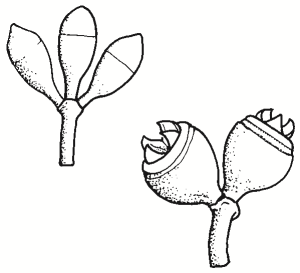Family:
Myrtaceae
Eucalyptus dalrympleana
Mountain Gum
Other Names:

Name Origin:
dalrympleana — after Richard Dalrymple Hay, former Chief Commissioner of NSW Forests.
Regional Subspecies:
Similar Species:
Distinguished from Candlebark (E. rubida) mainly by its glaucous juvenile and intermediate leaves.
Occurrence:
Regional:
Mostly in upper reaches of catchments including Tooma, Maragle and Paddy’s River-Burra Valley.
Australia:
Qld, NSW, Vic, Tas.
Habitat:
Grassy or sclerophyll woodland or forest on loamy or sandy soils at higher elevations.
Habit:
Tree to 40 m high with smooth bark on lower trunk shedding in long ribbons. Large crown of glossy green leaves.
Site Preference:
Moist, well-drained deep soils. Tolerates frost.
Characteristics:
Fast-growing. Develops spreading habit in open situations. Hybridises with Candlebark on Northern Tablelands.
Seed Collection:
Early Dec to late May. Monitor closely, as seeds released 3-8 weeks after maturity. Trees fallen for timber are ideal seed source.
Propagation:
From seed (± 250 viable seeds per gram).
Regeneration:
From seed after fire.
VALUES:
Shade & Shelter:
Could be included in wide windbreaks as high-level cover.
Wildlife:
Important hollow source for birds, including the Sooty Owl, and mammals, including the Yellow-bellied Glider.
Timber:
Straight-grained, moderately coarse and hard, but not durable. Density about 740 kg/m3. Similar but superior to Candlebark timber. Used in framing, paneling, flooring, joinery and tool handles. Useful timber for farm forestry planting on sheltered sites.
Other:
Leaves produce red-orange dye with alum as mordant.
